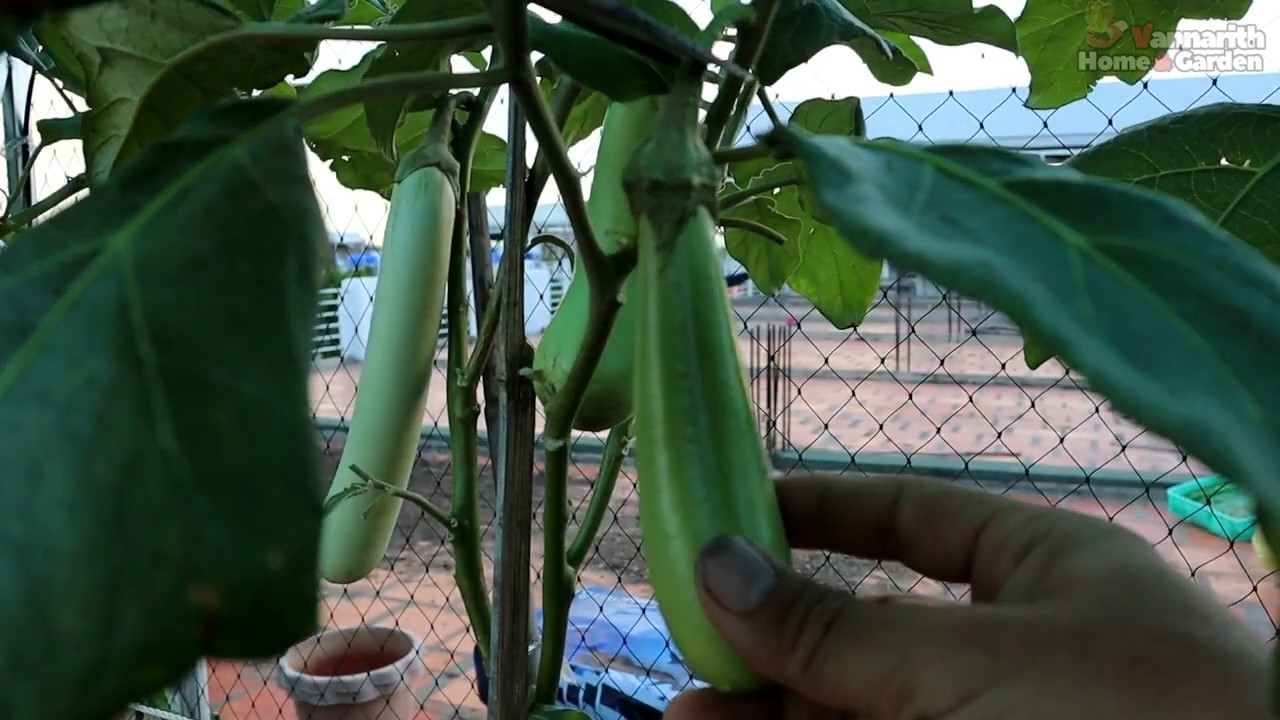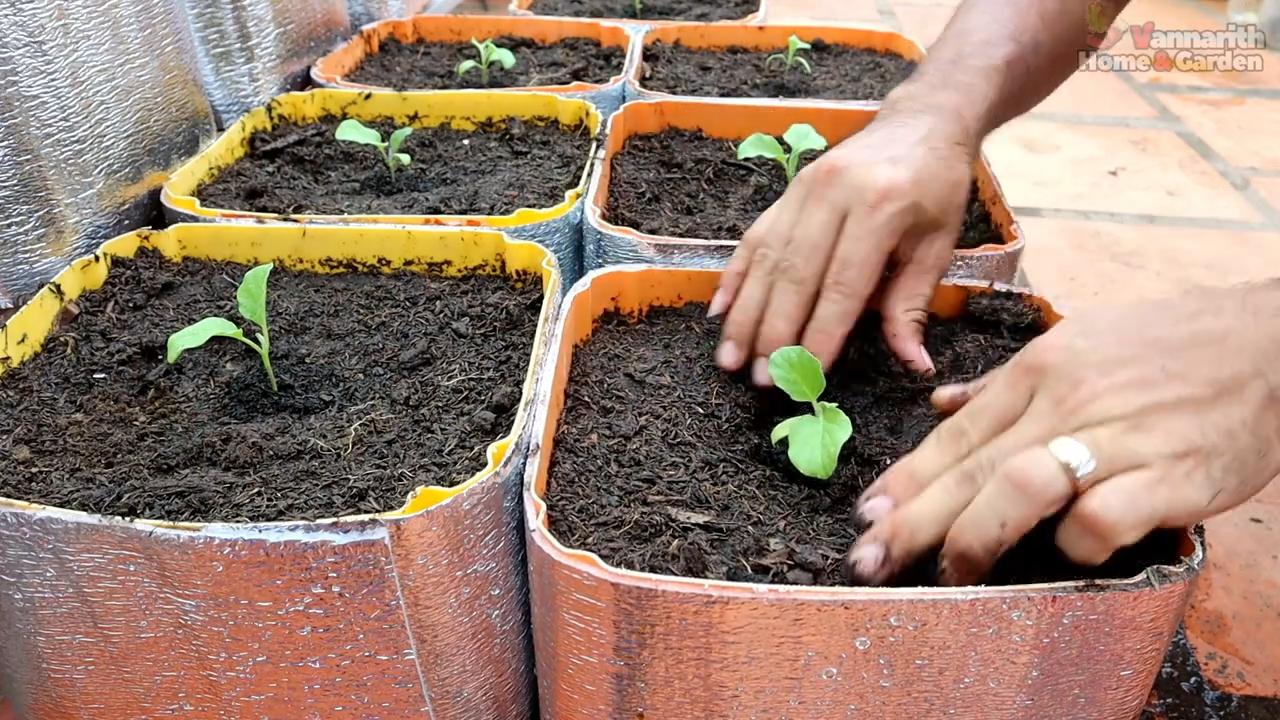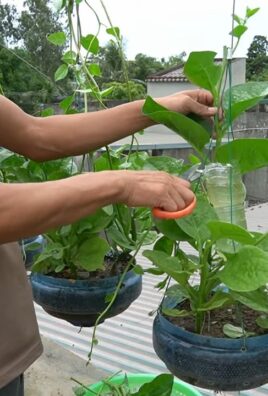Growing Eggplants at Home can feel like a daunting task, but trust me, with a few simple tricks and a little DIY magic, you can be harvesting your own delicious, glossy eggplants in no time! Imagine serving up a homemade eggplant parmesan, knowing you nurtured those beauties from tiny seedlings to plump, flavorful fruits. Sounds good, right?
Eggplants, also known as aubergines, have a rich history, originating in India and making their way across the globe. They’ve been cultivated for centuries, appearing in diverse cuisines from the Mediterranean to Asia. For generations, gardeners have passed down secrets for successful eggplant cultivation, and I’m excited to share some of those time-tested tips with you.
Why bother with the effort of growing your own eggplants? Well, for starters, the taste of a homegrown eggplant, picked fresh from the vine, is simply unmatched. Plus, you have complete control over what goes into your garden, ensuring you’re growing healthy, organic produce for yourself and your family. Many people struggle with getting their eggplants to thrive, often facing issues like blossom-end rot or pest infestations. But don’t worry! This DIY guide is packed with practical solutions and clever hacks to help you overcome these challenges and enjoy a bountiful harvest. I’m here to show you that growing eggplants at home is easier than you think!

Growing Eggplants Yourself: Your Comprehensive DIY Guide
Hello garden friends! I’m thrilled to introduce you to the world of growing eggplants today. Eggplants, also known as aubergines, are not only delicious but also beautiful to look at. With this guide, I’ll show you how you can successfully grow these Mediterranean beauties in your garden or on your balcony. Don’t worry, it’s easier than you think!
Why Grow Eggplants Yourself?
- Freshness and Flavor: Homegrown eggplants simply taste better! They are more aromatic and have a firmer texture than those from the supermarket.
- Variety: In stores, you usually only find the classic, dark purple eggplants. When you grow them yourself, you can choose from a huge variety of colors, shapes, and sizes. Think of white, striped, green, or even orange eggplants!
- Control over Growing Methods: You decide whether to grow organically and which fertilizers to use. This way, you can ensure that your eggplants are free of harmful pesticides.
- Satisfaction: There’s hardly anything more wonderful than harvesting the fruits of your own labor. Growing eggplants is a rewarding experience that will bring you a lot of joy.
What You Need for Growing Eggplants
- Eggplant seeds or young plants: Choose a variety that suits your climate and space conditions.
- Seed-starting mix: For starting the seeds.
- Pots or seed trays: For starting seeds.
- Potting soil: For transplanting into larger pots or outdoors.
- Fertilizer: Eggplants are heavy feeders and require sufficient nutrients.
- Watering can or garden hose: For watering.
- Plant stakes: To support the plants, especially when they bear fruit.
- Garden shears: For pruning.
- (Optional) Greenhouse or cold frame: For starting seeds and protecting the plants from cold.
Sowing and Starting Seeds: The Foundation for a Bountiful Harvest
Eggplants need a long growing season, so it’s important to start them early. I usually start in February or March.
- Prepare the starter pots: Fill your seed trays or small pots with seed-starting mix. Press the soil down lightly.
- Sow the seeds: Place one to two eggplant seeds per pot or cell on the soil. Cover the seeds with a thin layer of soil (about 0.5 cm / 0.2 inches).
- Water: Gently moisten the soil with a spray bottle or a watering can with a fine rose. The soil should be damp, but not wet.
- Location: Place the starter pots in a warm and bright location. A temperature of 22-25°C (72-77°F) is ideal for germination. A mini-greenhouse or a heat mat can help maintain the temperature.
- Germination: Germination usually takes 1-2 weeks. Keep the soil moist during this time.
- Pricking Out: Once the seedlings have developed their first true leaves (in addition to the seed leaves), it’s time to prick them out. This means you carefully take the small seedlings out of the starter pots and transplant them into larger pots (approx. 8-10 cm / 3-4 inches in diameter) with potting soil. Be careful not to damage the roots.
Transplanting into the Garden or Larger Pots
Once the eggplant plants are strong enough and there is no more danger of frost (usually mid-May), they can be transplanted outdoors or into larger pots.
- Prepare the soil: Eggplants prefer a sunny location with loose, humus-rich, and well-draining soil. Prepare the soil by working in compost or organic fertilizer.
- Hardening Off: Before you plant them outdoors, you should harden off the plants for a few days. This means placing them outside for a few hours during the day to get them used to the sun and cooler temperatures.
- Planting: Dig planting holes that are slightly larger than the root balls of the eggplant plants. Carefully place the plants in and fill the holes with soil. Press the soil down lightly and water the plants thoroughly.
- Planting distance: Ensure sufficient planting distance. Eggplants need space to develop. A distance of 50-60 cm (20-24 inches) between plants and 70-80 cm (28-32 inches) between rows is ideal.
- Supporting: Place a plant stake next to each plant right after planting. Eggplants can bend over under the weight of the fruit.
Caring for Eggplant Plants: Watering, Fertilizing, Pruning
Proper care is crucial for a bountiful eggplant harvest.
- Watering: Eggplants need regular water, especially during flowering and fruit formation. It’s best to water in the morning or evening to avoid evaporation. Avoid waterlogging.
- Fertilizing: Eggplants are heavy feeders and need sufficient nutrients. Fertilize the plants regularly with an organic fertilizer or a special eggplant fertilizer. Start fertilizing about 2-3 weeks after transplanting.
- Mulching: Mulch the soil around the eggplant plants with straw, hay, or grass clippings. This keeps the soil moist, suppresses weeds, and protects the fruit from dirt.
- Pruning Suckers: Regularly remove side shoots that form in the leaf axils. This encourages the formation of larger fruits. Leave only the main stem and a few side shoots.
- Pruning: Prune the plants back after harvesting. Remove dead or diseased leaves and shoots. This promotes growth for the next year.
- Protecting from pests and diseases: Eggplants can be infested by various pests and diseases, such as aphids, spider mites, potato beetles, or fungal diseases. Check the plants regularly and combat pests and diseases early with appropriate measures. I prefer biological agents.
Harvest: The Reward for Your Efforts
The harvest time for eggplants depends on the variety and weather conditions. As a rule, the first fruits can be harvested about 2-3 months after transplanting.
- Signs of ripeness: Eggplants are ripe when they have a shiny, plump skin and yield slightly to pressure. The color should be intense.
- Harvesting: Cut the eggplants with a sharp knife or garden shears. Leave a small stem on the fruit.
- Storage: Eggplants do not last long. It’s best to store them in the refrigerator, where they will keep for a few days.
Common Problems and Solutions
Spider mites: Increase humidity and combat spider mites with predatory mites or special sprays.
Aphids: Combat aphids with a jet of water, insecticidal soap, or beneficial insects like ladybugs.

Conclusion
So, there you have it! Growing eggplants at home, while it might seem daunting at first, is a deeply rewarding experience that brings the vibrant flavors of summer right to your table. We’ve explored the key steps, from selecting the right varieties and starting seeds indoors to transplanting, providing essential care, and finally, harvesting those beautiful, glossy fruits.
But why should you embark on this journey? Beyond the sheer satisfaction of nurturing a plant from seed to harvest, growing your own eggplants offers several compelling advantages. First and foremost, you gain complete control over the growing process. You can choose organic methods, avoiding harmful pesticides and herbicides, ensuring that your eggplants are as healthy and delicious as possible. This is especially important for those concerned about the environmental impact of commercial farming and the potential health risks associated with conventionally grown produce.
Furthermore, homegrown eggplants often boast a superior flavor compared to store-bought varieties. Freshly picked eggplants have a richer, more intense taste and a firmer texture. The difference is truly remarkable, and once you’ve tasted a homegrown eggplant, you’ll likely never go back to the supermarket version.
And let’s not forget the cost savings! While there’s an initial investment in seeds, soil, and perhaps some basic gardening tools, growing your own eggplants can significantly reduce your grocery bill, especially if you’re a frequent eggplant consumer. Plus, you’ll have a surplus to share with friends and neighbors, spreading the joy of homegrown goodness.
Ready to take your eggplant game to the next level? Consider experimenting with different varieties. From the classic Black Beauty to the slender Japanese eggplants and the colorful Thai varieties, there’s a whole world of eggplant flavors and textures to explore. You can also try different growing techniques, such as container gardening or vertical gardening, to maximize your space and yield.
Don’t be afraid to get creative in the kitchen, too! Eggplants are incredibly versatile and can be used in a wide range of dishes, from classic eggplant parmesan and ratatouille to grilled eggplant salads and spicy eggplant curries. The possibilities are endless!
We encourage you to give growing eggplants at home a try. It’s a fun, educational, and ultimately delicious experience that will connect you with nature and provide you with a bounty of fresh, healthy produce. And most importantly, don’t be discouraged if you encounter challenges along the way. Gardening is a learning process, and every mistake is an opportunity to grow (pun intended!).
So, grab some seeds, get your hands dirty, and start growing your own eggplants today! We’d love to hear about your experiences. Share your tips, tricks, and photos in the comments below. Let’s build a community of eggplant enthusiasts and inspire others to discover the joys of homegrown produce. Happy gardening!
Frequently Asked Questions (FAQ)
1. What are the best eggplant varieties to grow at home?
The best eggplant varieties for home growing depend on your climate, growing space, and personal preferences. For beginners, the ‘Black Beauty’ is a classic choice, known for its reliable yields and large, dark purple fruits. ‘Ichiban’ is a Japanese variety that produces long, slender eggplants with a mild flavor. ‘Fairy Tale’ is a compact variety that’s well-suited for container gardening and produces small, striped eggplants. ‘Thai Green’ and ‘Thai Purple’ are excellent choices if you enjoy spicy Asian cuisine. Consider your local climate and growing conditions when making your selection. Look for varieties that are disease-resistant and well-suited to your region’s growing season.
2. How do I start eggplant seeds indoors?
Starting eggplant seeds indoors is crucial, especially in regions with short growing seasons. Start seeds 6-8 weeks before the last expected frost. Use a seed-starting mix and sow seeds about ¼ inch deep in individual pots or seed trays. Keep the soil consistently moist but not waterlogged. Eggplants need warm temperatures to germinate, ideally between 75-85°F (24-29°C). Use a heat mat to provide bottom heat if necessary. Once the seedlings emerge, provide them with plenty of light, either from a sunny window or a grow light. Harden off the seedlings gradually by exposing them to outdoor conditions for increasing periods before transplanting them into the garden.
3. When and how should I transplant eggplant seedlings?
Transplant eggplant seedlings into the garden after the danger of frost has passed and the soil has warmed up to at least 60°F (15°C). Choose a sunny location with well-drained soil. Space the plants 2-3 feet apart, depending on the variety. Dig a hole slightly larger than the root ball and gently remove the seedling from its pot. Place the seedling in the hole and backfill with soil, gently firming it around the base of the plant. Water thoroughly after transplanting. Consider adding a layer of mulch around the plants to help retain moisture and suppress weeds.
4. What are the common pests and diseases that affect eggplants, and how can I control them?
Eggplants are susceptible to several pests and diseases, including aphids, flea beetles, spider mites, and verticillium wilt. Regularly inspect your plants for signs of infestation or disease. Aphids can be controlled with insecticidal soap or a strong blast of water. Flea beetles can be deterred with row covers or diatomaceous earth. Spider mites can be treated with miticides or by increasing humidity. Verticillium wilt is a soilborne disease that can be prevented by planting disease-resistant varieties and practicing crop rotation. If you encounter any serious pest or disease problems, consult with your local agricultural extension office for advice on appropriate control measures.
5. How often should I water and fertilize my eggplants?
Eggplants need consistent moisture, especially during hot weather. Water deeply and regularly, aiming to keep the soil consistently moist but not waterlogged. Avoid overhead watering, as this can promote fungal diseases. Fertilize eggplants regularly with a balanced fertilizer, following the instructions on the product label. You can also amend the soil with compost or aged manure to provide essential nutrients. Side-dress the plants with fertilizer every few weeks during the growing season to encourage vigorous growth and abundant fruit production.
6. How do I know when my eggplants are ripe and ready to harvest?
Eggplants are typically ready to harvest when they are glossy, firm, and have reached their mature size and color. The skin should be smooth and unblemished. Gently press the skin with your thumb; if it leaves a slight indentation, the eggplant is ripe. Use a sharp knife or pruning shears to cut the eggplant from the plant, leaving a short stem attached. Harvest eggplants regularly to encourage continued fruit production. Overripe eggplants can become bitter and seedy.
7. Can I grow eggplants in containers?
Yes, eggplants can be successfully grown in containers, making them a great option for gardeners with limited space. Choose a large container, at least 5 gallons in size, with good drainage. Use a high-quality potting mix and provide the plants with plenty of sunlight, water, and fertilizer. Compact varieties like ‘Fairy Tale’ are particularly well-suited for container gardening. Be sure to stake or cage the plants to provide support as they grow.
8. How can I prevent blossom-end rot in my eggplants?
Blossom-end rot is a common problem in eggplants, caused by a calcium deficiency. It manifests as a dark, sunken spot on the bottom of the fruit. To prevent blossom-end rot, ensure that your soil is rich in calcium and that the plants receive consistent watering. You can add lime to the soil before planting to increase calcium levels. Avoid letting the soil dry out completely, as this can interfere with calcium uptake. You can also use a calcium-containing foliar spray to supplement the plants’ calcium intake.
9. What are some creative ways to use homegrown eggplants in cooking?
Homegrown eggplants are incredibly versatile and can be used in a wide range of dishes. Try grilling or roasting eggplant slices and adding them to salads or sandwiches. Make a classic eggplant parmesan or ratatouille. Use eggplant in curries, stir-fries, or stews. Stuff eggplants with rice, vegetables, or meat. Make baba ghanoush, a Middle Eastern dip made from roasted eggplant. The possibilities are endless! Experiment with different recipes and flavors to discover your favorite ways to enjoy your homegrown eggplants.
10. How do I store harvested eggplants?
Store harvested eggplants in the refrigerator for up to a week. Wrap them loosely in plastic wrap or place them in a perforated plastic bag to prevent them from drying out. Avoid storing eggplants near ethylene-producing fruits, such as apples and bananas, as this can cause them to ripen too quickly. Eggplants can also be frozen for longer storage. To freeze eggplants, blanch them in boiling water for a few minutes, then cool them in ice water. Drain well and pack them into freezer bags or containers.




Leave a Comment